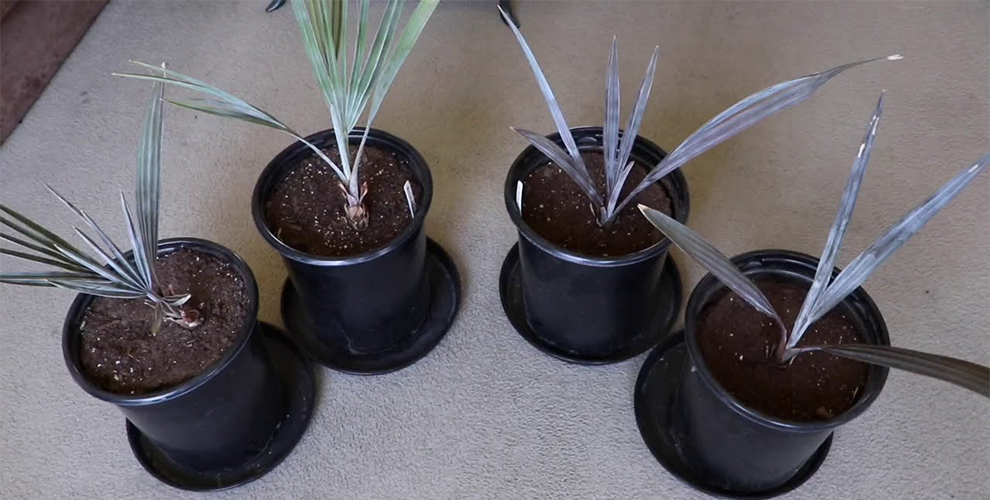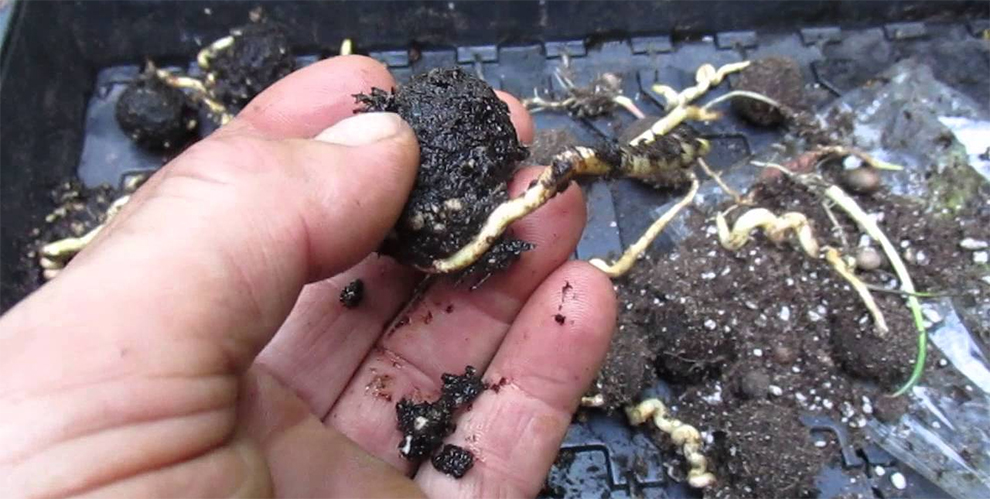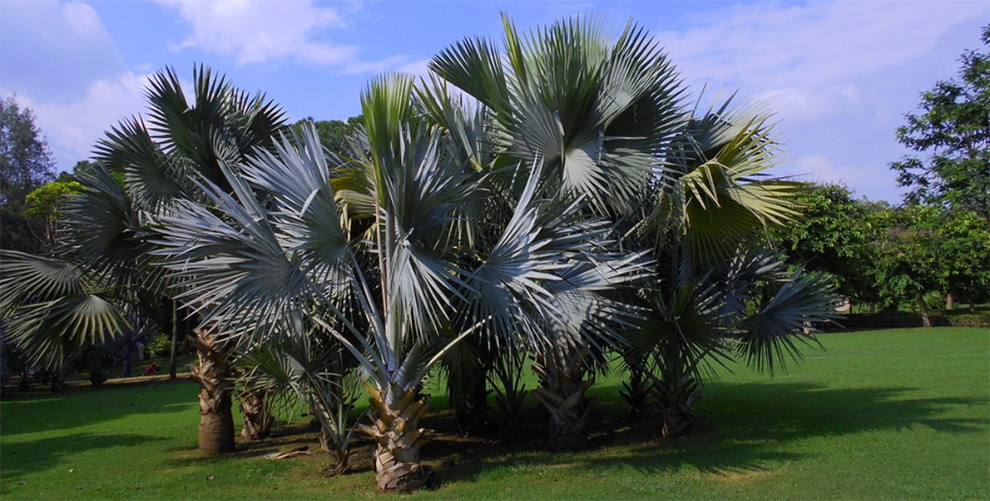How To Grow Bismarck Palm Plant From Seed (Bismarckia Nobilis)
To grow Bismarck palm from seeds, plant them in a pot about 1-2 inches deep and water well. The soil used should be well draining. Also, maintain the moisture levels in the soil for easy germination.

Bismarck Palm is a medium-sized Palm that grows between 50 and 60 feet with a 20-foot spread. Hence, it needs ample room to grow.
Its light blue leaves and size make it one unique and attractive specimen in any yard or garden. It is an easy-growing plant provided you have an idea of how to grow Bismarck Palm from seed.
The plant thrives in USDA zones ten and more. However, it can also survive in warmer climates in hardiness zone 9.The Bismarck Palm seeds should be planted 1-2 inches deep in well-draining soil. They usually sprout in six to eight weeks and sometimes longer.
Fortunately, it is moderately disease resistant. As the plant approaches maturity, it becomes reasonably drought-tolerant as well but they are sensitive to extreme cold.
Can You Grow A Bismarck Palm From Seed?
Yes, you can grow these types of palm trees from seed. But it is vital to understand that it can be a challenging and slow process. The plant might take several years to grow before it reaches maturity.
Do You Soak Bismarck Palm Seeds Before Planting?

Yes, you must soak the Bismarck seeds in water before planting. It helps soften the hard outer shell and better the possibility of successful germination. In addition, dipping the seeds also help eliminate any inhibitors or chemical found on the seed coat that can curtail the germination process.
In a bowl, fill warm water to soak the Bismarck Palm seeds. Add the seeds into the bowl fully submerged in the water. Let them remain soaked for at least a day or two. Change the water every 12 hours.
Once you soak the seeds, plant them in a well-draining soil mix and offer them good care. Keep the soil moist, and provide the seedlings with bright, indirect light and warm temperatures.
How To Plant Bismarck Palm Seeds?
If you hope to grow a Bismarck tree, start by planting the seeds around 2 inches deep for germination in soil pH ranging from 6 – 7. Water well. You can use a germination tray or small sized pot for the same.
Once they sprout, transfer them to a pot and place them in a location that receives ample light. Water deeply once a week or only when the soil feels dry. Fertilize from spring to fall to meet the nutritional deficiencies.
Step 1 – Select a container
Pick a container at least six inches or 15 cm deep. It should have good drainage holes to prevent water from accumulating at the bottom.
Step 2 – Prepare the soil mixture
Bismarck Palms thrive in well-draining soil full of nutrients. So, mix equal parts of peat moss, sand, and perlite to make a well-draining soil mixture.
Step 3 – Fill the container
Fill the container with the soil mix, leaving about 2.5 cm of space on the top.
Step 4 – Plant the seeds
Now plant the seeds at least one to two inches deep into the soil mixture with their pointed end facing downwards.
Step 5 – Water the soil
Once planted, water the soil well, leaving it evenly moist, not soggy or waterlogged.
Step 6 – Offer good care
Bismarck seeds demand warm temperatures and consistent moisture to germinate. So, keep the soil moist and maintain the temperature at 80-85 degrees Fahrenheit. It might take several months or weeks for the seeds to germinate.
Step 7 – Transplant the seedlings
After the seedlings have developed some leaves, you can transplant them into separate containers in well-draining soil. Keep the soil moist and offer it indirect, bright light.
How To Germinate Bismarck Palm Seeds?

As stated, for germination, you must soak the seeds in warm water for at least a day or two. It helps soften the hard outer shell and better the rate of germination. Following this, you prepare the soil as Bismarck Palms thrive in well-draining soil rich in nutrients.
So, mix equal parts of perlite, peat moss, and sand into the soil. Once your soil is ready, you must cautiously plant the seeds about 1-2 inches deep into the soil with their pointed head facing downwards.
Water the soil well to ensure that the soil is evenly moist and not waterlogged. For active germination, you need to offer the seeds a humid environment. So, cover the container with a clear plastic bag or plastic wrap and place it in a bright, warm spot with indirect sun.
Expose the seeds to a consistently warm temperature and provide them moisture to germinate. Try maintaining the temperature between 80 – 84°F.
It will take the seeds a few weeks or even months to germinate. Once the seeds sprout and develop a few leaves, remove the plastic cover, but continue caring for the plant to grow well.
Maintaining The Bismarck Plant
Learning how to germinate Bismarckia Nobilis seeds will help you have healthy seedlings. But, for them to grow into thriving seedlings to plants and trees, you need to take care of the following points.
A. Light
Bismarck Palms demand a lot of sunlight. They are native to areas that receive ample sun. Hence, Bismarck Palms need at least six hours of direct sun daily to grow.
The plant loves full sun exposure, meaning you must plant them in a spot that receives direct sun for most of the day. Thus, if you plant these Palms indoors or in a shade region, they might not get the necessary sun to grow well, and their health and growth may be negatively affected.
However, please note excessive sun can also damage the plant. So, if you reside in a spot with dry and hot summers, you must provide your Palm shade during the hottest parts of the day to avoid dehydration and sunburn.
Generally, it helps to grow them in a location that receives abundant light and guards them against excessive heat and strong winds.
B. Water

Bismarck Palms need regular watering to thrive. However, you must be careful with the degree and frequency and not overwater the Palm. It can result in root rot and other problems. They may also kill or damage the plant.
Water regularly during the growing season from spring to fall. The frequency will depend on the soil conditions and the climate, but you must water it deeply at least once a week. The plant should sit in well-draining soil, wherein the water flows through effortlessly.
Water less frequently if the soil is heavy and tends to hold water to avoid overwatering. While watering, it is vital to water deeply to saturate the root zone. It implies that the soil must be moist to a depth of at least six inches.
Bismarck Palms are moderately drought-tolerant after they establish. However, they still need frequent watering to remain healthy. Proper drainage is crucial for the Bismarck Palm.
So, if the soil around the plant becomes waterlogged, the roots may damage easily, resulting in the plant suffering. To promote drainage, plant the Bismarck Palm in a raised bed or add organic matter to the soil to better the structure.
C. Soil
Bismarck Palms cherish well-draining soil rich in organic matter. The soil should have a pH between 6.0 to 7.0. If the soil is very alkaline, the plant might find it challenging to absorb the nutrients properly, resulting in poor development and growth.
The soil must be well-draining with a loose texture that lets water flow easily. Sandy, loam soil can be a good choice for the Bismarck Palms as it offers excellent drainage while retaining adequate moisture to keep the roots hydrated.
Bismarck Palms love organic matter like well-rotted manure or compost. This organic matter helps boost soil fertility and structure and promotes healthy root development and growth.
Mulching around the base can also help the plant retain moisture and suppress weeds. You can use organic mulches like bark or wood chips that break down over time and add organic matter to the soil.
D. Fertilizer
Consider fertilizing during the growing season, from spring to fall, but do not add any feed in the winter months as the plant’s growth is slow during this time. You can use a balanced fertilizer with equal parts nitrogen, phosphorus, and potassium.
Opt for a slow-release formula that offers the plant the necessary nutrients over a longer duration. The amount of plant feed depends on the Palm’s size and age. Generally, one pound feed for every inch of trunk diameter is ideal.
You should spread the fertilizer around the base, ensuring it does not come in contact with the trunk. Water the fertilizer thoroughly post-application to ensure it reaches the root system.
Bismarck Palms like regular but moderate fertilization. You can apply the plant feed every three to four months during the growing season.
E. Pruning

After learning how to grow a Bismarck Palm from seeds and have a healthy plant at hand, next comes pruning.
Bismarck Palms generally do not need much pruning as they can naturally keep a tidy appearance. But you can remove the dead fronds to maintain the plant’s appearance and avoid potential safety hazards.
In addition, you can also chop yellowed fronds to elevate the plant’s appearance, but you can leave them on the plant as they will eventually fall off on their own.
Further, you can trim the lower fronds if they obstruct the walkway or touch the ground but do not remove too many fronds as that can harm the plant.
F. Overwintering

Bismarck Palms are tropical plants and are not cold-hardy. Therefore, they need protection from freezing temperatures during the winter months.
Bring your Bismarck Palm indoors if you live in an area with freezing temperatures during the winter. Choose a sunny spot with adequate space and temperature, ideally between 70-85°F and keep the soil moist.
If you have a large Bismarck Palm and it is not practical to move it indoors, you can protect it with a cover. Wrap the plant with a frost blanket or burlap and secure it with rope or twine. The veil will help insulate the plant and keep it warm.
When Is The Best Time To Plant The Bismarck Seeds?
The best time to plant the Bismarck seeds is in spring or summer, as the temperature is warm and the days are long. Bismarck Palms thrive in warm climates with plenty of sunlight and heat to germinate and grow successfully.
Planting the seeds during the spring or summer allows them to take advantage of the warm weather and long days, which promotes healthy growth and development.
Common Mistakes To Avoid While Planting Bismarck Seeds
Here are some prevalent mistakes you must avoid when planting Bismarck seeds:
1. Planting the seeds too deep – Ideally, you must not sow the Bismarck seeds deeper than two inches in well-draining soil. When you plant too deep, you prevent the seeds from germinating properly.
2. Underwatering or overwatering – Bismarck Palms love regular watering, but you must not under or overwater the Palm. Overwatering can result in rotting, whereas underwatering can cause the seeds to dry or die.
3. Employing low-quality soil – Bismarck Palms thrive in well-draining soil full of nutrients. Using poor-quality soil that lacks nutrients or is compacted can stunt the plant’s growth.
4. Planting in a location with inadequate sun – Bismarck Palms need full sun to thrive and grow. Planting them in a spot with insufficient sun can cause poor development and stunted growth.
5. Fertilizing too little or too much – Bismarck Palms demand regular feeding. Excessive feeding can burn young plants, whereas too little plant food can stunt their growth.
6. Ignoring pests and diseases – Bismarck Palms are susceptible to some pests and diseases. Thus, you must inspect the plant regularly for pest or disease attacks. Ignoring it can lead to severe damage or kill the Palm.
Related: Dwarf Palm Varieties | Fan Palm Species
With this, we hope that now you know how to grow Bismarck. But please note that these seeds have a low germination rate. Hence, not every seed will sprout.
In addition, the Bismarck Palms have a slow growth rate. Thus, it may take several years for this Palm to reach maturity. So, keep at it, be patient, and offer consistent care to boost your chances of success.
